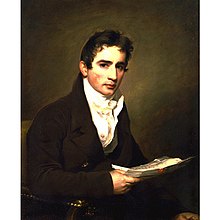John Sergeant (politician)
John Sergeant (December 5, 1779 – November 23, 1852) was an American politician who represented Pennsylvania in the United States House of Representatives. He was the National Republican Party's vice presidential nominee in the 1832 presidential election, serving on a ticket with Senator Henry Clay.
- For other persons named John Sergeant, see John Sergeant (disambiguation)
John Sergeant | |
|---|---|
 | |
| Chair of the House Judiciary Committee | |
| In office 1839–1841 | |
| Preceded by | Francis Thomas |
| Succeeded by | Daniel D. Barnard |
| In office 1822–1823 | |
| Preceded by | Hugh Nelson |
| Succeeded by | Hugh Nelson |
| Member of the U.S. House of Representatives from Pennsylvania | |
| In office March 4, 1837 – September 15, 1841 | |
| Preceded by | Joseph Ingersoll |
| Succeeded by | Joseph Ingersoll |
| Constituency | 2nd district |
| In office March 4, 1827 – March 3, 1829 | |
| Preceded by | Thomas Kittera |
| Succeeded by | Daniel H. Miller |
| Constituency | 2nd district |
| In office October 10, 1815 – March 3, 1823 | |
| Preceded by | Jonathan Williams |
| Succeeded by | Samuel Breck |
| Constituency | 1st district, Seat D |
| Personal details | |
| Born | December 5, 1779 Philadelphia, Pennsylvania, U.S. |
| Died | November 23, 1852 (aged 72) Philadelphia, Pennsylvania, U.S. |
| Political party | Federalist (Before 1828) National Republican (1828–1834) Whig (1834–1852) |
| Spouse(s) | Margaretta Watmough
( m. after 1813) |
| Education | University of Pennsylvania Princeton University (BA) |
After graduating from Princeton University, Sergeant served in the Philadelphia government and won election to the Pennsylvania House of Representatives. As a member of the Federalist Party, he won election to the United States House of Representatives, serving from 1815 to 1823. In Congress, he supported Clay's American System and opposed the extension of slavery, voting against the Missouri Compromise.
After serving as president of the Pennsylvania Board of Canal Commissioners, Sergeant returned to Congress in 1827. He lost his 1829 re-election campaign and became a legal counsel for the Second Bank of the United States.[1] In the 1832 presidential election, the ticket of Clay and Sergeant was soundly defeated by the Democratic ticket of Andrew Jackson and Martin Van Buren. After the election, Sergeant joined the Whig Party and again returned to Congress, serving from 1837 to 1841. He was also the president of the Pennsylvania constitutional convention in 1838. He retired from public office in 1841 and resumed his law practice.
Early life
Sergeant was born in Philadelphia on December 5, 1779. He was a son of Margaret (née Spencer) Sergeant and Jonathan Dickinson Sergeant, a lawyer who represented New Jersey in the Second Continental Congress and served as the Pennsylvania Attorney General.[2] His brother Thomas Sergeant, served as Pennsylvania Secretary of State, Attorney General and on the Supreme Court of Pennsylvania.[3]
Sergeant was educated in the common schools and at the University of Pennsylvania at Philadelphia.[4] He graduated from Princeton College in 1795. He became a lawyer and, after being admitted to the bar in 1799, practiced law for fifty years.[5]
Career
In 1800, Sergeant became deputy attorney general for Philadelphia and then commissioner of bankruptcy for Pennsylvania the following year. He was a member of the Pennsylvania State House of Representatives from 1808 to 1810. He was elected as a Federalist to the United States House of Representatives to fill the vacancy caused by the death of Jonathan Williams. He was re-elected three times, serving from October 10, 1815 to March 3, 1823, and managed to reach the position of chairman of the United States House Committee on the Judiciary. Sergeant was a strong backer of Henry Clay's American System and the Second Bank of the United States in Congress, and even traveled to Europe to negotiate loans to the Bank. He was also a strong opponent of slavery who voted against the Missouri Compromise.[6] He then retired, albeit temporarily, from Congress.[4]
In 1825, he was president of the Pennsylvania Board of Canal Commissioners. The following year, he was an envoy to the Panama Congress of 1826 but arrived after the Congress had concluded its discussions. He returned to the U.S. House of Representatives for the term starting March 4, 1827.[4]
He failed re-election to the following term and left Congress for the second time on March 3, 1829. He then became legal counsel to the Bank of the United States.[4]
Vice Presidential Candidate
Sergeant was Henry Clay's running mate on the National Republican ticket during the 1832 presidential election but lost to Andrew Jackson and Martin Van Buren in a landslide and again retreated from public life.
After his Vice Presidential candidacy, he returned as president of the Pennsylvania constitutional convention in 1838, and then was elected as a Whig to the U.S. House of Representatives. He served this last time from March 4, 1837 until he resigned on September 15, 1841, and again was chair of the Committee on the Judiciary for the 1837 – 1839 term. He returned to his law practice, declining offers of a cabinet or diplomatic position from the new Whig administration.
In 1844 he was considered for the Whig vice presidential nomination, to once again run with Clay, but at the convention lost out to Theodore Frelinghuysen.
Personal life
On June 23, 1813 he married Margaretta Watmough, daughter of James Horatio Watmough and Anna (née Carmick) Watmough.[7][8] With Margaretta he fathered ten children, all but one surviving infancy. Among his children were:[9]
- Margaretta Sergeant (1814–1886), who married Major General George Meade, Commander of the Union Army of the Potomac from the Battle of Gettysburg until the end of the Civil War.[10]
- Sarah Sergeant (1817–1850), who married Henry A. Wise, the 33rd Governor of Virginia.[9]
- Katherine Sergeant (1825–1910), who married Harry Augustus Cram (parents of John Sergeant Cram).[9]
- William Sergeant (1829–1865), who served in the Civil War and was mortally wounded at the Battle of White Oak Road.[11]
Sergeant died in Philadelphia on November 23, 1852 and was interred at Laurel Hill Cemetery Section L, Lots 1-7.[12]
Descendants
His grandsons, John Sergeant Wise, John Sergeant Cram, and Richard Alsop Wise, as well as his great-grandson, John Crain Kunkel, were also prominent in politics.[4]
References
- Monroe, R. Daniel (2003). The Republican Vision of John Tyler. Texas A&M University Press. p. 102. ISBN 9781585442164. Retrieved 15 October 2019.
- Where No Man Has Gone Before. Washington: Government Printing Office. 2007. p. 419. ISBN 9780160845789. Retrieved 15 October 2019.
- Halfield, D.D., Edwin F. (1878). The Pennsylvania Magazine of History and Biography. Historical Society of Pennsylvania. pp. 438–442. Retrieved 15 October 2019.
- "SERGEANT, John - Biographical Information". bioguide.congress.gov. Biographical Directory of the United States Congress. Retrieved 15 October 2019.
- Sergeant, John (1832). Select Speeches of John Sergeant, of Pennsylvania [1818-1828]. E.L. Carey & A. Hart. p. 185. Retrieved 15 October 2019.
- Johnson, David (2012). John Randolph of Roanoke. LSU Press. p. 184. ISBN 9780807143988. Retrieved 15 October 2019.
- Watmough, James H. (1905). "Letters of James H. Watmough to his Wife, 1785". The Pennsylvania Magazine of History and Biography. Historical Society of Pennsylvania. Retrieved 15 October 2019.
- Treese, Lorett (2001). Hope Lodge and Mather Mill. Stackpole Books. p. 21. ISBN 9780811724715. Retrieved 15 October 2019.
- Wise, Jennings Cropper (1918). Col. John Wise of England and Virginia (1617-1695): His Ancestors and Descendants. Bell Books and Stationery Company. p. 285. Retrieved 15 October 2019.
- Hunt, Jeffrey (2018). Meade and Lee at Bristoe Station: The Problems of Command and Strategy after Gettysburg, from Brandy Station to the Buckland Races, August 1 to October 31, 1863. Savas Beatie. p. 97. ISBN 9781611213973. Retrieved 15 October 2019.
- Appletons' Annual Cyclopædia and Register of Important Events of the Year ... D. Appleton & Company. 1888. p. 468. Retrieved 15 October 2019.
- "SERGEANT, John". history.house.gov. US House of Representatives: History, Art & Archives. Retrieved 15 October 2019.
External links
- United States Congress. "John Sergeant (id: S000246)". Biographical Directory of the United States Congress.
- John Sergeant at Find a Grave
- The Political Graveyard
| U.S. House of Representatives | ||
|---|---|---|
| Preceded by Jonathan Williams |
Member of the U.S. House of Representatives from Pennsylvania's 1st congressional district Seat D 1815–1823 |
Succeeded by Samuel Breck |
| Preceded by Hugh Nelson |
Chair of the House Judiciary Committee 1819–1822 |
Succeeded by Hugh Nelson |
| Preceded by Thomas Kittera |
Member of the U.S. House of Representatives from Pennsylvania's 2nd congressional district 1827–1829 |
Succeeded by Daniel H. Miller |
| Preceded by Joseph Ingersoll |
Member of the U.S. House of Representatives from Pennsylvania's 2nd congressional district 1837–1841 |
Succeeded by Joseph Ingersoll |
| Preceded by Francis Thomas |
Chair of the House Judiciary Committee 1839–1841 |
Succeeded by Daniel D. Barnard |
| Party political offices | ||
| Preceded by Andrew Gregg |
Federalist nominee for Governor of Pennsylvania 1826 |
Party dissolved |
| Preceded by Richard Rush |
National Republican nominee for Vice President of the United States 1832 | |
